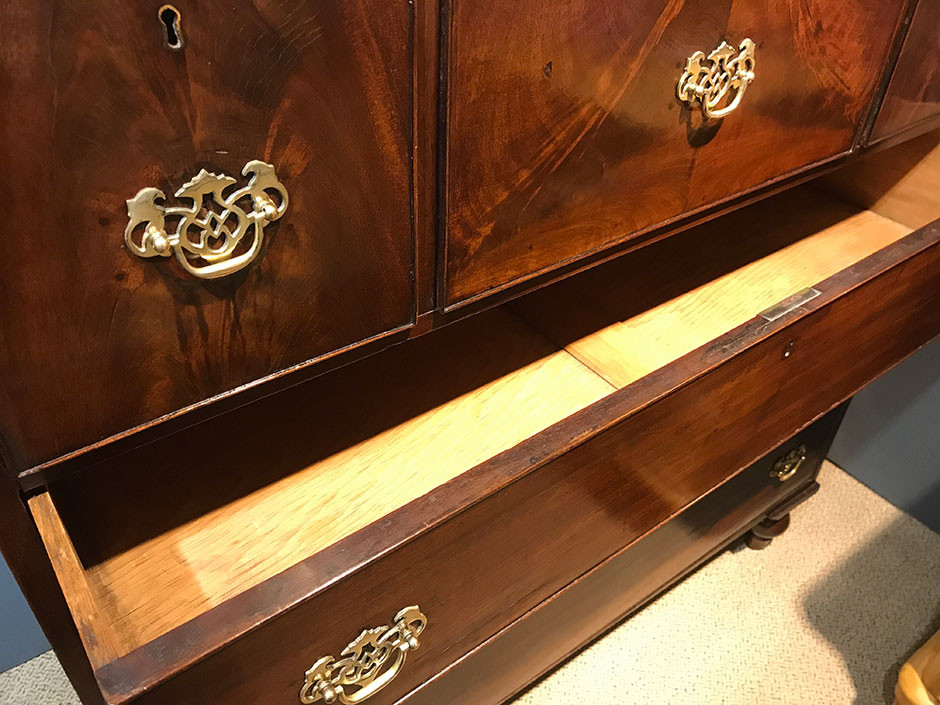
Thick, glossy walnuts. Plum-pudding mahogany. Lustrous, mellow patinas. Antique furniture is making a comeback and we’re increasingly finding that it’s solid chest of drawers antiques dealers and auction houses are snapping up.
The antique chest of drawers dates back to the 16th and 17th centuries, when social change was rapidly developing in Europe. Back then, you’d expect to see big joints secured by iron nails - it was only at the end of the 17th century that dovetailing was used and craftsmen began experimenting with different designs.
Graduated drawers soon developed into the antique tall chest of drawers we can find today, which can reach 1.5 metres in height. From the end of the 17th century onwards, there was an explosion of design, many of which demand high prices from antique chest of drawers dealers today.
Moving on from the plain Georgian chest of drawers, one of the most popular decorative techniques was marquetry, which uses veneer to create decorative patterns. A fascination with oriental art can be seen on a range of antique chest of drawers for sale in respected centres, shops and auctions. This whimsical movement used methods such as bambooing, japanning (the European version of lacquering and caning. A standout expression of this style can be seen in the antique bank of drawers of Brighton Pavilion, designed for the Prince of Wales (later George IV) in the early 19th-century.
Why invest in antique chest of drawers?
Remarkable quality
The domestic necessity for antique chest of drawers throughout history means the quality and craftsmanship used to build them is higher quality over today’s disposable chipboard counterparts. You get more wood for your cash with an antique chest of drawers: solid oak was the preferred timber in Britain, but there are now many antique walnut chest of drawers for sale, as this wood grew increasingly popular for its rich colour.
Extraordinary diversity
The purpose of an antique chest of drawers may be utilitarian, but the diversity of the pieces that have evolved over time is enormous. Much of the collectability lies in these individual differences - construction, shape, size, decoration (mainly determined by the region of origin, maker or period it was manufactured). Then there’s the timber difference, determining colonial access or luxurious extravagance with everything from antique chest of drawers in smooth-and-light satinwood to darkly streaked Brazilian rosewood.
How much do chest of drawer antiques value?
- 1700: An antique mahogany chest of drawers, decorated with a beautiful oyster veneer, can value at up to £10,000.
- 1750: A Rococo commode (small chest of drawers) from Venice, with floral posies and trellised borders, can see a hammer coming down at up to £8,000.
- 1765-80: Find yourself a Chippendale-style antique chest of drawers from the George III period and you can see their value reach up to £20,000. Characteristics associated with this style include chamfered serpentine tops, angles carved with Chinese or Gothic fretwork, Rococo handle and shaped bracket feet.
- 1850: Although vulnerable to damage and chipping of the veneer, a Dutch antique mahogany chest of drawers from the 19th century, decorated with ribbon-tied swags, foliage-filled vases and fan spandrels can value at £2,000-£4,000. Even with a couple of handles missing.
- 1875-1900: Land upon a pair of British Wellington chest of drawers and you’ll bump up the value significantly. A couple made of burr-walnut with six graduated drawers, Classical-style acanthus leaves and drapery corbels can value between £10,000 and £15,000.
Tips for chest of drawers antiques collectors
- Keep a close eye on re-made drawers, often detectable by variations in style and construction. These can often be relatively easy to detect - an antique oak chest of drawers for sale made up of old carcases of timber or antique walnut chest of drawers, for example.
- As a general rule, small chest of drawers tend to hold more commercial value. Which means there are often fakes lingering about. Browse our well-priced range of large and small chest of drawers antiques from reputable dealers to find a genuine investment.
- Check the feet. Replacement feet are common in Georgian chest of drawers, as bun feet have often been switched for bracket feet. This could’ve been due to wear-and-tear, woodworm or simply changing fashions. Make sure you look underneath the chest for old holes where these bun feet would have been fitted originally.
- Examine the handles. They could be repositioned or changed entirely. Bruise marks on the woodwork will show you where the original handles (primarily drop handles) would have rubbed off the timber.
- Saw marks can help you determine dates. Straight saw marks signify antique chest of drawers from the first half of the 18th century. From the end of the century, however, circular saws were used, leaving visible circular saw marks on the inside of carcases.
- Don’t completely be put off by restoration. If it’s done to a high standard and isn’t intended to deceive, it shouldn’t adversely affect the value of the antique chest of drawers.
More and more people are bringing a statement antique chest of drawers into their homes. Not only are they are mark of taste, these storage pieces are true investment pieces and collectors are realising that they can find a bargain if they know where to look. From coveted George III antique mahogany chest of drawers to beautiful walnut banks and even a dedicated antique pine chest of drawers range, you can guarantee our collection is packed with genuine, quality antiques at fair prices. Browse the full selection of antique chest of drawers or come visit Hemswell Antiques in person - it’s the best way to see those perfect patinas in all their glory.